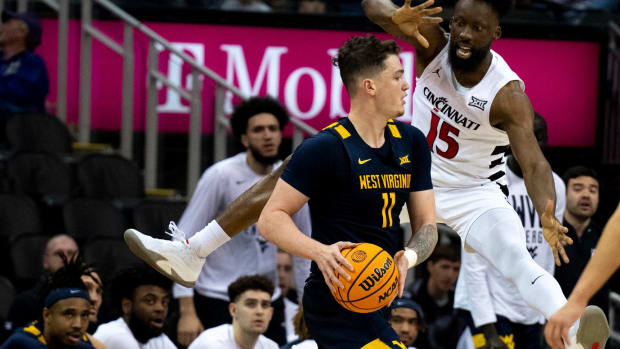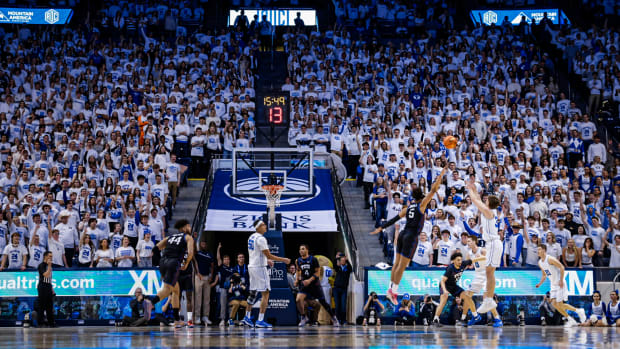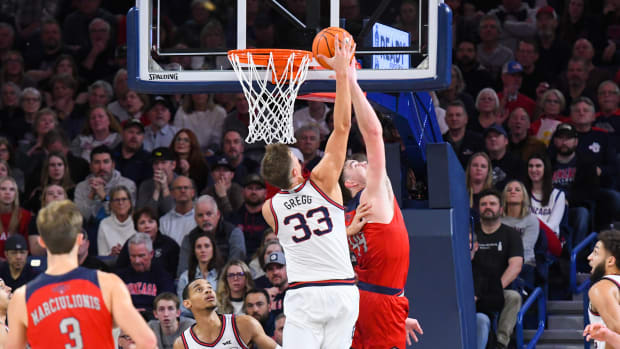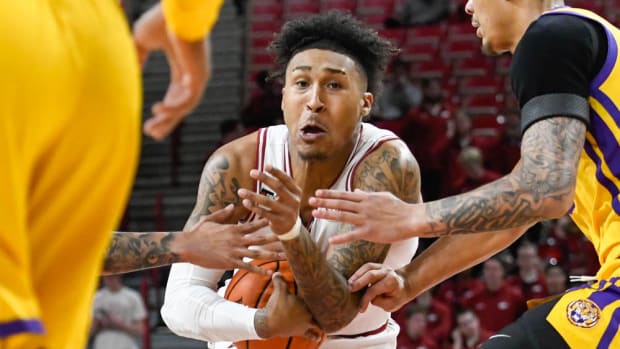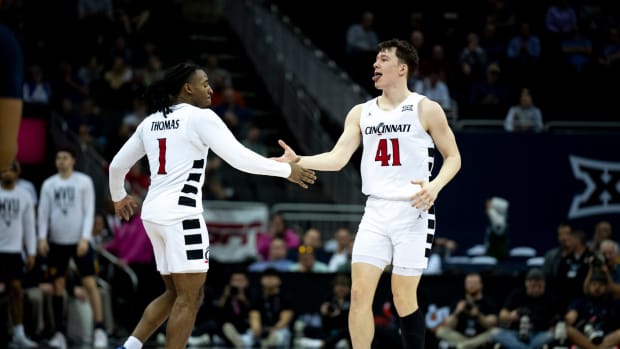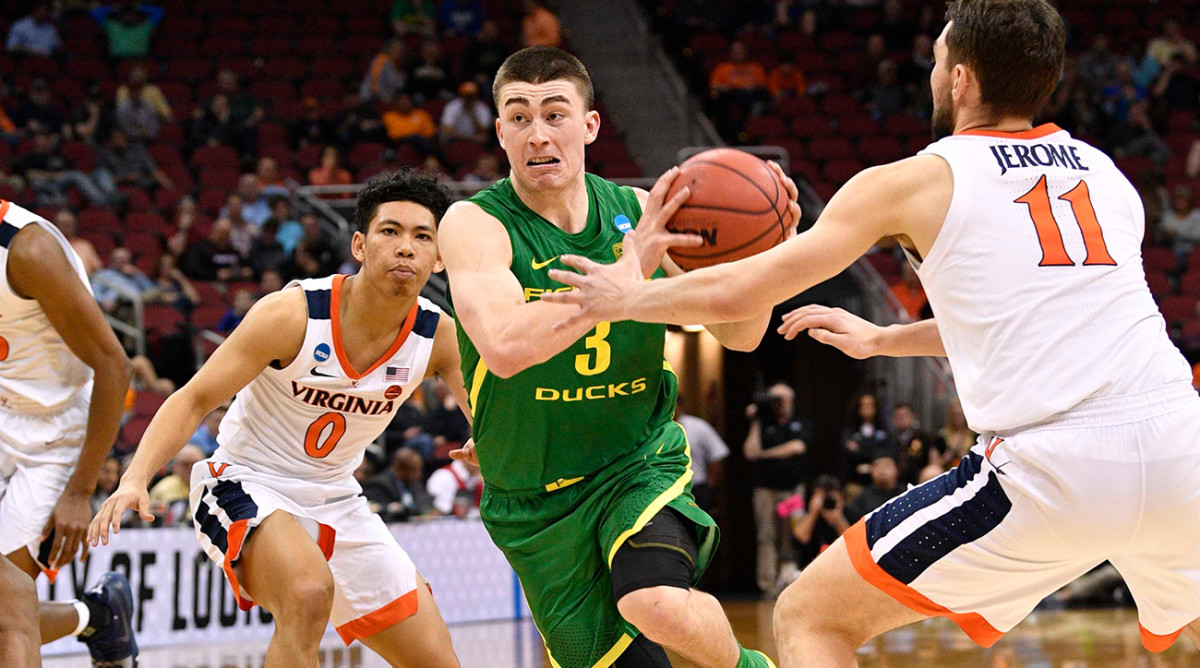
Pac-12 Preview: Talent at the Top Should Close Gap With Fellow High-Majors
As part of SI.com's preview of the 2019–20 college basketball season, we're breaking down each of the seven major conferences, plus the best of the rest. We've done the AAC, ACC, Big East, Big 12, Big Ten and SEC; next up for our conference previews is the Pac-12, complete with our analyst's breakdowns of each team and a projected order of finish.
The Big Picture
The Pac-12 survived the first weekend of March Madness last season… so baby steps. The conference, though, was still a mess overall, as it was plagued by parity and mediocrity. Talent-wise, though, there are signs of optimism for this upcoming campaign, as four different teams have multiple incoming five-star commits. But is there a serious national title contender residing in the Pac-12? Can the Pac-12 close the gap between itself and the five other high-major conferences? While an affirmative to the former seems very unlikely, I think the latter should be the conference’s biggest goal in 2019-20, starting with not embarrassing itself in non-conference play.
Conference POY: Tres Tinkle, Oregon State
The Beavers most likely won’t be a contender to win the conference, but there is no Pac-12 player more important to his team than the fifth-year senior. Tinkle was second in the conference in minutes played per game last season at 36.4, only behind former teammate Stephen Thompson Jr.’s 36.6. Oregon State doesn’t have a lot of depth, so it needs strong performances from its best players to stay competitive. Tinkle consistently delivered, averaging 20.8 points, 8.1 rebounds, 3.8 assists and 1.7 steals per game. The 6’8” forward impacts the game in so many ways, and he’s primed to have a monster final campaign in Corvallis.
Newcomer of the Year: Isaiah Stewart, Washington
This was a tough decision between Stewart and Arizona guard Nico Mannion. While I think Mannion has the higher ceiling, I think Stewart has the greater floor and will be relied upon more by his team, especially in the early part of the season when Washington is without Kentucky transfer Quade Green. The five-star big man is a bully in the paint, and he’ll fit into the Noah Dickerson role seamlessly. His physical presence should lead to several double-double outputs throughout the entire season, and he’s going to be an absolute load for opposing teams to stop.
Darkhorse Team to Win the Conference: Arizona State
I think there’s a clear top-four this year in Oregon, Colorado, Arizona and Washington, but if I had to pick one that could disrupt at the top of the standings, let’s go running with the (Sun) Devils. Jitterbug Remy Martin, sharpshooter (and now healthy) Rob Edwards and JUCO star transfer Alonzo Verge make up a formidable backcourt. Kimani Lawrence, Taeshon Cherry and Romello White all return from last year’s group to form a solid stable of forwards. With Verge headlining the newcomers, ASU quietly restocked its roster quite nicely with JUCO transfers and freshmen. Losing Luguentz Dort and Zylan Cheatham hurts, however the Sun Devils have a capable roster. Will that translate into more consistency under Bobby Hurley? That’s the big question, and the answer to that will be key to whether ASU can surprisingly contend for the Pac-12 crown.
First-Team All-Conference
Nico Mannion, guard, Arizona
McKinley Wright, guard, Colorado
Payton Pritchard, guard, Oregon
Tres Tinkle, forward, Oregon State
Isaiah Stewart, forward, Washington
Sixth Man: Tyler Bey, forward, Colorado
Predicted Order of Finish
1. Oregon
The Ducks lost Kenny Wooten and Louis King from last season’s Sweet 16 team. But Dana Altman has expertly reloaded his team with talented freshmen or transfers over the past few offseasons, and this one was no different. Five-star freshmen CJ Walker and N’Faly Dante (once he becomes eligible in December) will be immediate contributors. And whether it’s through the Mountain West (Anthony Mathis, Shakur Juiston) or going the JUCO route (Chris Duarte), Oregon shored up its rotation with plenty of experienced talent too. Having one of the best point guards in the conference (Payton Pritchard) and the best coach (Altman) doesn’t hurt, either.
2. Colorado
The Buffaloes were one of the hottest teams at the end of conference play, winning nine of their last 11 games in the regular season. With star point guard McKinley Wright, do-it-all forward Tyler Bey and pretty much every meaningful contributor from that team returning, this is a squad that is well-positioned to make some noise nationally. Getting big man Dallas Walton back from an ACL tear is a big boost for Colorado’s frontcourt depth as well. The Buffaloes may not have as much top-tier talent as the other Pac-12 contenders, but this is a seasoned group that has plenty of experience playing with one another.
3. Arizona
The 2018-19 campaign was the rockiest of Sean Miller’s time in Tucson, with issues arising on and off the court. The pain of last season has quickly turned into preseason optimism, though, thanks to a batch of fresh faces led by incoming five-stars Nico Mannion and Josh Green. Losing Brandon Williams for the season is a major blow, however Arizona returns four players from last year’s rotation, headlined by former Duke transfer Chase Jeter. Graduate transfer Max Hazzard comes over from UC Irvine, and he will have an enhanced role in the backcourt with Williams out of the picture. The Wildcats have a gluttony of talent, but will it all come together in March? That’s been the dark cloud looming over the Miller era, and this season has a make-or-break feel to his time in the desert.
4. Washington
A team with two incoming five-star freshmen and a major transfer in the fold as well, sound familiar? Like Oregon and Arizona, Washington had no problem replacing last year’s key departures with tantalizing talent. Isaiah Stewart and Jaden McDaniels have completely different games, yet they form a frontcourt with tremendous overall upside. On the other hand, there could be some early-season struggles at guard until Quade Green is eligible to play in December. The Kentucky transfer has big shoes to fill in replacing Pac-12 Player of the Year Jaylen Nowell, but he certainly has the skill set to take over games.
5. Arizona State
Talent has never been a problem under Bobby Hurley, but consistency certainly has. The Sun Devils have a good mix of returning experience and intriguing incoming pieces, and they’ve racked up strong non-conference victories in the Hurley era. Yet, a Jekyll-and-Hyde persona in Pac-12 play, especially away from Tempe, has limited ASU’s ceiling. If it wants to be a tournament team this time around, it has to discontinue that alarming trend.
6. USC
The Trojans are another Pac-12 team that has been plagued by inconsistency in recent seasons despite accumulating enviable talent all over their roster. This season is no different, as incoming five-star big men Onyeka Okongwu and Isaiah Mobley will likely lead to more three-forward lineups by Andy Enfield instead of his traditional one big and four shooters. The key for this group will be the play at point guard, where Elijah Weaver looks to take a major step forward in his sophomore season.
7. UCLA
Mick Cronin is the new sheriff in Westwood, and luckily for him, expectations aren’t sky-high in Year 1. The Bruins have the capability to surprise this season, though, as they have two very promising guards in redshirt freshman Tyger Campbell and sophomore David Singleton along with plenty of frontcourt depth. But will the Bruins play at a slower pace under Cronin, or will the former Cincinnati coach adjust to his personnel and adopt a faster style of play? This will be a fascinating team to watch.
8. Oregon State
Tres Tinkle is back for a fifth season, and the Beavers have a couple other key pieces returning as well in guard Ethan Thompson and shot-blocking machine Kylor Kelley. The problem with this team, as it has been in recent seasons, is depth. The talent gap between Oregon State’s three top players and the rest of the roster, especially the bench, is rather large. If Tinkle, Thompson and Kelley are at their best, the Beavers can compete with anyone in the conference. Oregon State doesn’t have enough reinforcements, however, if even one is off his game or injured.
9. Utah
There is no coach in the Pac-12 who does better with less than Larry Krystkowiak. Every year, Utah finishes better than its preseason projection. And this season may be his biggest challenge yet. Losing Sedrick Barefield to graduation and Donnie Tillman to transfer is already an uphill climb, however Utah is a team largely comprised of freshmen. Outside of a sophomore triumvirate of Timmy Allen (12.2 PPG last season), Both Gach (7.7 PPG) and Riley Batting (6.4 PPG) along with JUCO transfer Alfonso Plummer, the rest of the roster is first-year players. So as much as I want to give Utah the Krystkowiak bump in these preseason rankings, it’s tough to envision the Utes finishing in the top half of the conference with this much turnover and inexperience.
10. Stanford
Quietly, the Jerod Haase era has been a major disappointment in Palo Alto. Stanford’s recruiting classes were inside the top 20 in 2017 and 2018, yet the Cardinal only finished a combined two games above .500 over that span in a struggling conference. Even with KZ Okpala in the NBA and a No. 59-ranked incoming recruiting class, Stanford has intriguing talent left in guard Daejon Davis and forward Oscar da Silva. But I have zero faith in Haase coaching up a good team this time around when he failed to do so with far more talented rosters.
11. Washington State
Washington State was one of the biggest winners of this year’s coaching carousel, as the Cougars hired San Francisco’s Kyle Smith to replace Ernie Kent. It’s hard to recruit top talent to Pullman, so the Cougars need to find a different method to succeed. Smith’s analytics-heavy coaching philosophy is a great way to give the Cougars edges despite being outmanned. It’ll be tough trying to replace Robert Franks’s volume scoring, though at least CJ Elleby is back after producing one of the most promising freshman campaigns in the Pac-12. I’m excited to see this experiment unfold at Wazzu, but the Cougs should still finish near the bottom of the conference in Year 1 under Smith.
12. California
Mark Fox has low expectations in his first year in Berkeley after the program bottomed out under Wyking Jones. The former Georgia and Nevada coach has a massive challenge ahead of him trying to bring Cal basketball back to relevancy. Returning guards Paris Austin and Matt Bradley along with the addition of Texas A&M-Corpus Christi transfer Kareem South make up the backcourt, which is the strength of this team. The Golden Bears still have a lot of weaknesses, though, and they’ll likely be one of the worst high-major teams in the country once again.

